Cantaloupes are a beloved summer fruit that can be grown in your own backyard. Understanding the plant growth stages or life cycle of cantaloupes is essential for successfully cultivating these delicious fruits. From the humble seed to the bountiful harvest, each stage plays a crucial role in the plant’s development.
In this article, I will provide an overview of the cantaloupe plant growth stages and offer tips on how to grow and care for your cantaloupe plants.
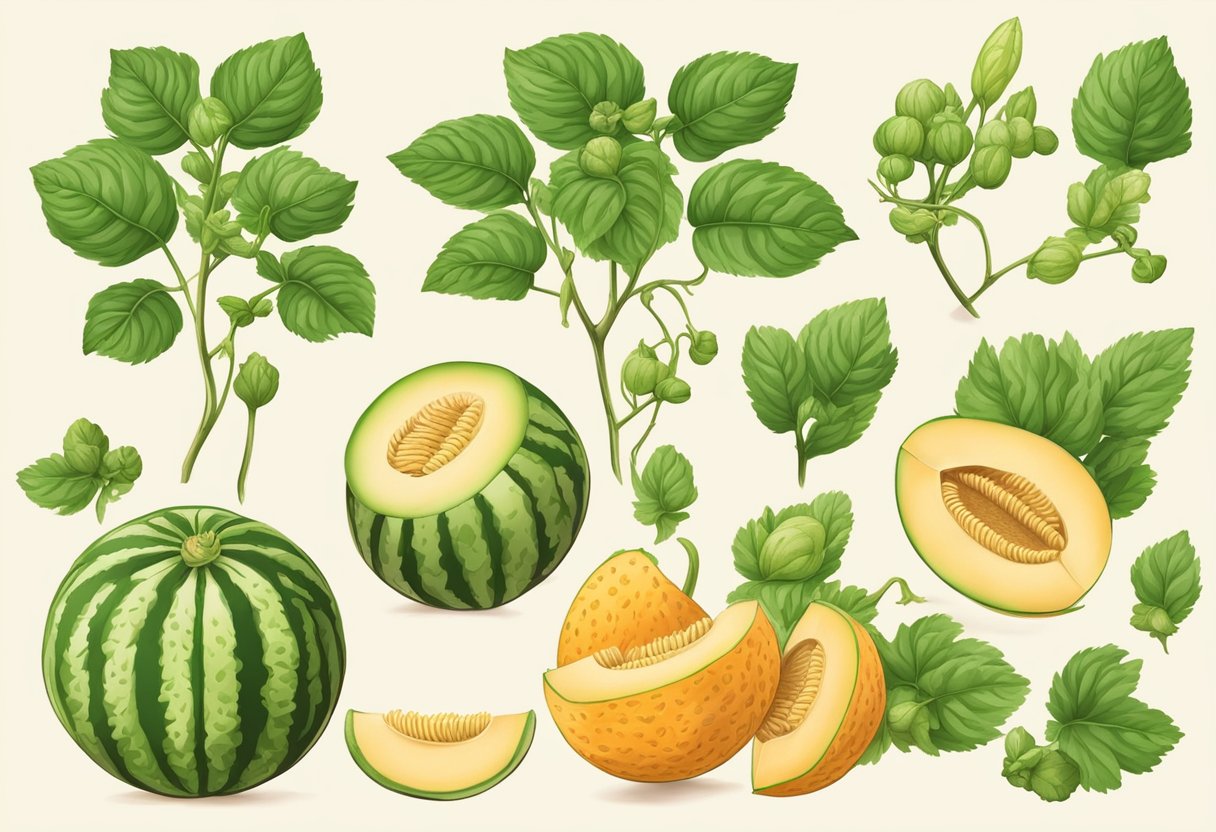
The cantaloupe plant, also known as Cucumis melo var. cantalupensis, is a member of the Cucurbitaceae family, which includes cucumbers, pumpkins, and squash. Cantaloupes are warm-season crops that require a long growing season, plenty of sunshine, and fertile, well-drained soil. The plant growth stages of cantaloupes include germination, seedling, vegetative growth, flowering, fruit set and development, and maturation and ripening. Each stage has its unique requirements, and understanding them is crucial for growing healthy and productive cantaloupe plants.
Key Takeaways
- Understanding the cantaloupe plant growth stages is essential for successfully cultivating these delicious fruits.
- Cantaloupes are warm-season crops that require a long growing season, plenty of sunshine, and fertile, well-drained soil.
- The plant growth stages of cantaloupes include germination, seedling, vegetative growth, flowering, fruit set and development, and maturation and ripening.
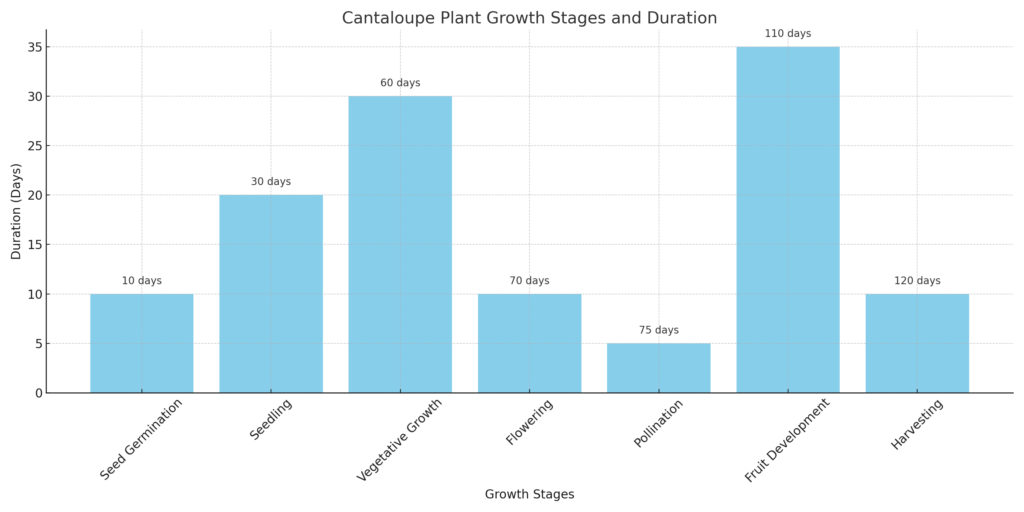
Cantaloupe Plant Taxonomy
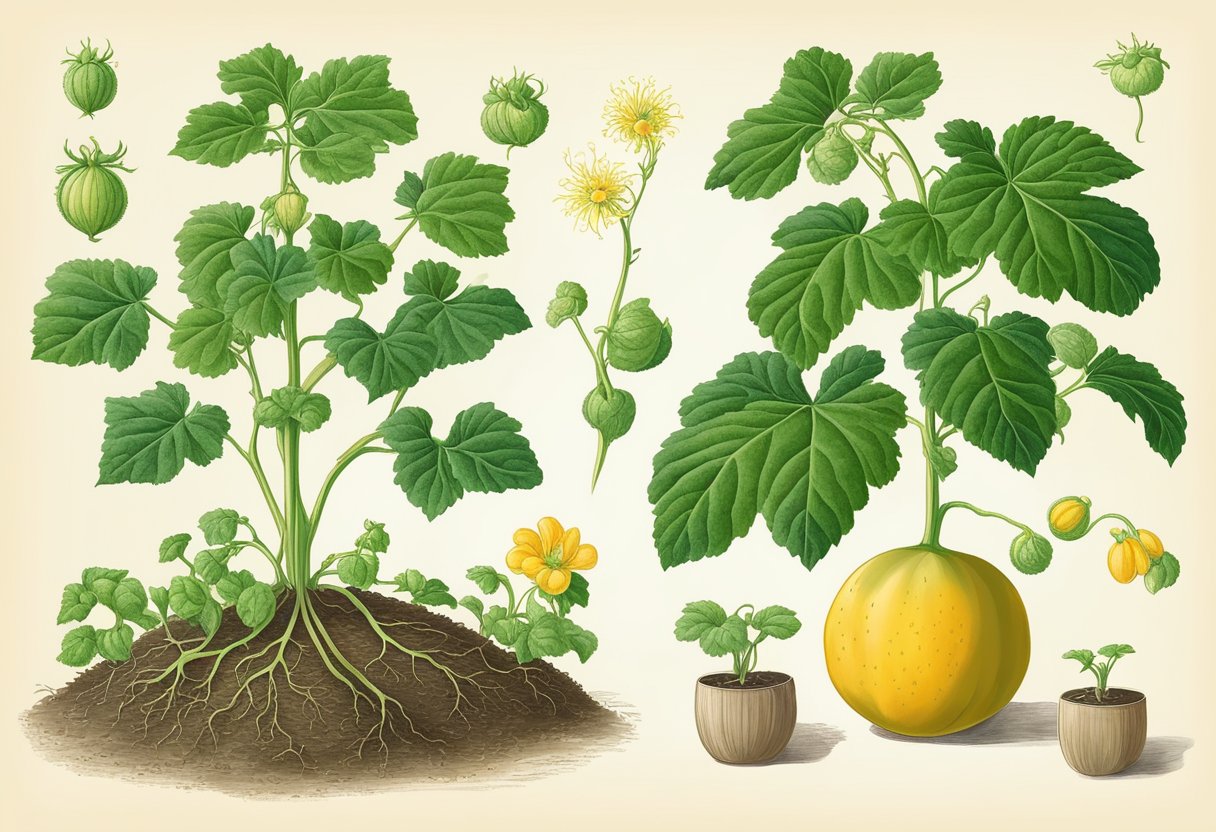
Cantaloupe, a member of the Cucurbitaceae family, is a species of muskmelon. It is scientifically known as Cucumis melo var. cantalupensis. Cantaloupes are a type of fruit that is grown for their sweet and juicy flesh. They are typically round or oval in shape and have a ribbed outer skin that is either smooth or rough.
Cantaloupe plants are annual vines that grow up to 3 feet tall. They have large, lobed leaves that are green in color and covered in fine hairs. The plants produce both male and female flowers, which are pollinated by bees. The fruit of the cantaloupe plant is a pepo, which means it is a type of berry with a hard rind.
The cantaloupe plant is closely related to other members of the Cucurbitaceae family, including cucumbers, squash, and pumpkins. These plants share many of the same characteristics, including their vine-like growth habit, lobed leaves, and production of both male and female flowers.
Cantaloupe is a type of fruit that belongs to the muskmelon species of the Cucurbitaceae family. It is an annual vine that produces sweet and juicy fruit with a ribbed outer skin. The plant is closely related to other members of the Cucurbitaceae family and shares many of the same characteristics.
Germination Stage
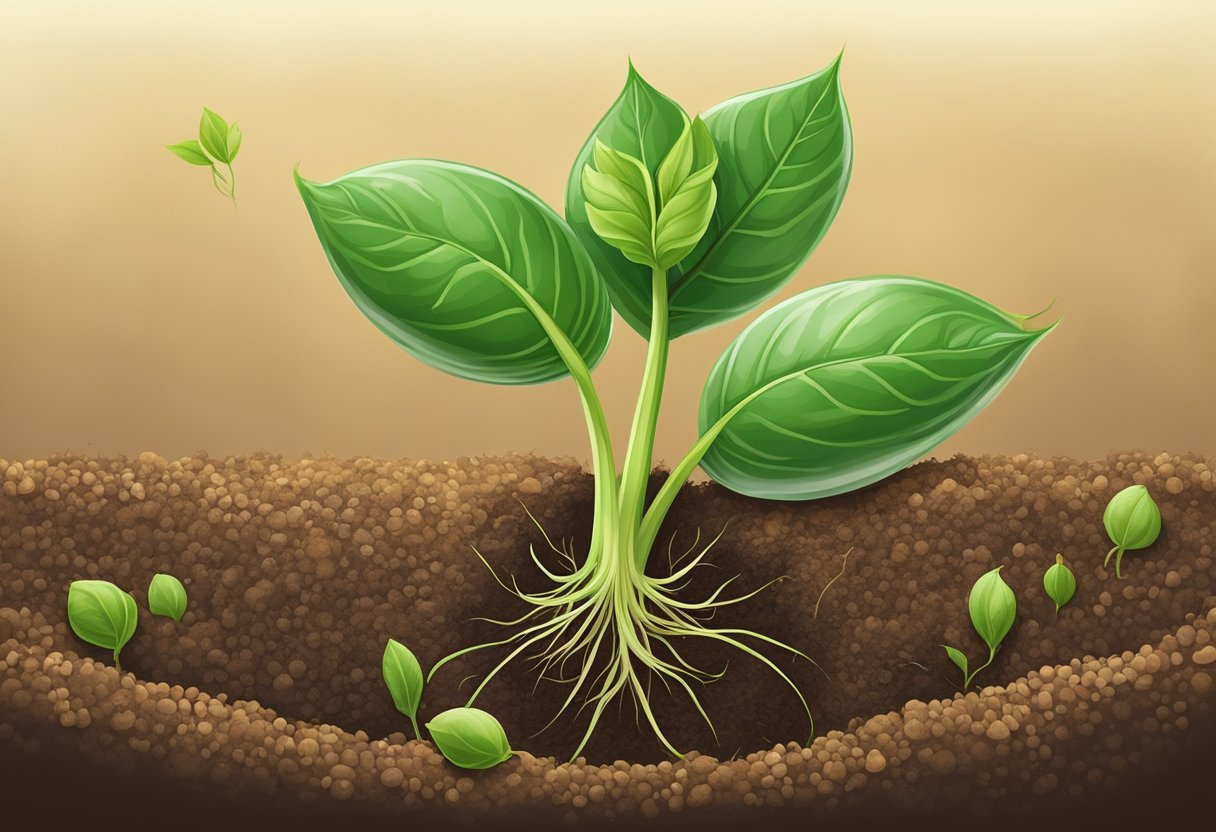
Seed Selection
When it comes to growing cantaloupes, selecting high-quality seeds is essential. I always choose seeds that are plump, uniform in size, and free from any cracks or damage. It’s also important to select seeds that are fresh and have not been stored for too long.
Germination Conditions
To ensure successful germination, the right conditions must be provided. Cantaloupe seeds require warm soil temperatures of at least 60°F to germinate. I prefer to start my seeds indoors 4 to 6 weeks before the last frost date in my area. This allows me to control the temperature and moisture levels, which are crucial for germination.
To germinate cantaloupe seeds, I fill seed trays with a high-quality seed starting mix and plant the seeds about ½ inch deep. I keep the soil moist but not waterlogged, and place the trays in a warm location with plenty of light. Once the seeds have germinated and sprouted their first true leaves, I transplant them into larger containers or directly into the garden.
By following these simple steps for seed selection and germination conditions, you can ensure a successful start to your cantaloupe plants.
Seedling Stage
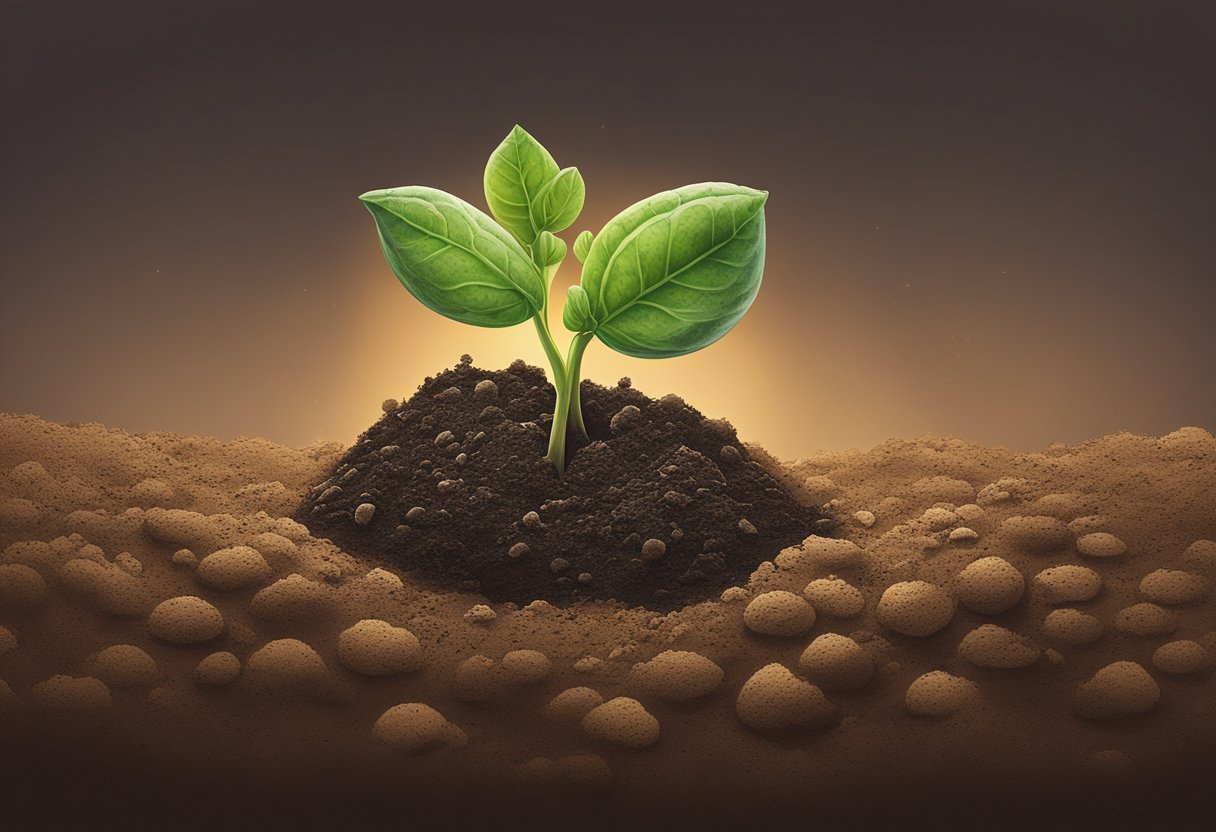
As a cantaloupe plant grows from a seed, it enters the seedling stage. This stage is critical, as the plant is still fragile and needs special care to grow into a healthy, mature plant. In this stage, the plant develops its first true leaves and begins to photosynthesize. Here are two important aspects of the seedling stage that you should keep in mind:
Transplanting Seedlings
When the cantaloupe seedlings have grown their first true leaves, they are ready to be transplanted into the garden. Before transplanting, it’s important to harden off the seedlings by gradually exposing them to outdoor conditions. This can be done by placing them outside for a few hours each day, gradually increasing the amount of time they spend outside. Once the seedlings are hardened off, they can be transplanted into the garden.
When transplanting, make sure to plant the seedlings deeply, burying the stem up to the first set of true leaves. This encourages the plant to develop a strong root system. Space the seedlings at least 18 inches apart to allow for proper growth and air circulation.
Nutrient Requirements
During the seedling stage, cantaloupe plants require a balanced diet of nutrients to grow into healthy plants. A nutrient-rich soil is essential for proper growth. Adding compost to the soil before planting can help provide the necessary nutrients.
It’s also important to provide the seedlings with a balanced fertilizer. A fertilizer with a ratio of 10-10-10 or 20-20-20 is ideal for the seedling stage. Apply the fertilizer according to the package instructions, taking care not to over-fertilize, which can damage the fragile seedlings.
By following these guidelines during the seedling stage, you can help ensure that your cantaloupe plants grow into healthy, mature plants that produce a bountiful harvest.
Vegetative Growth
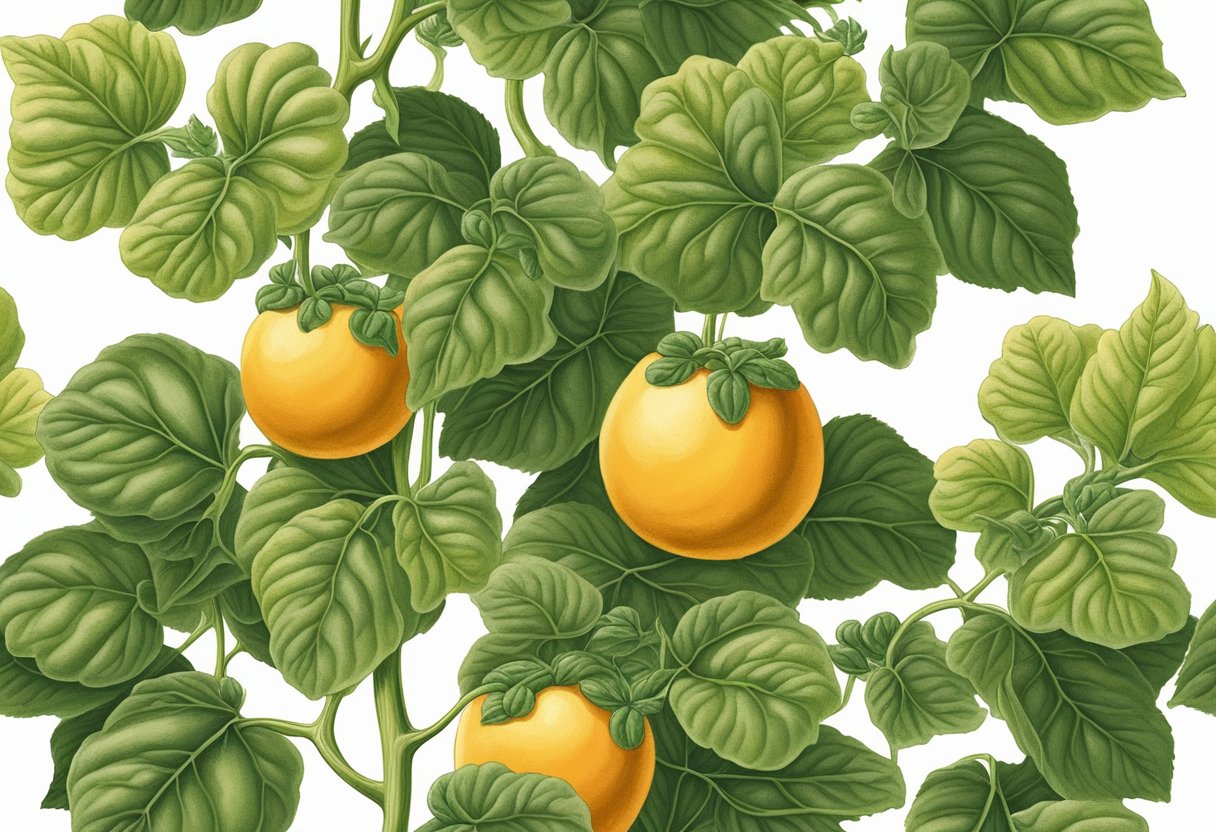
As a cantaloupe plant grows, it passes through several stages of development. The first stage is the vegetative growth stage, which is characterized by the development of the plant’s vines and leaves.
Vine Development
During the vegetative growth stage, the cantaloupe plant’s vines grow rapidly, reaching lengths of up to 10 feet or more. These vines are covered in small, green leaves that help the plant to photosynthesize and produce energy.
As the vines grow, they will begin to produce small tendrils that allow the plant to climb and attach to nearby structures. These tendrils are an important part of the cantaloupe plant’s growth, as they allow the vine to support the weight of the developing fruit.
Leaf Growth
In addition to vine growth, the vegetative growth stage is also characterized by the development of the cantaloupe plant’s leaves. These leaves are essential for the plant’s survival, as they help to absorb sunlight and produce energy through photosynthesis.
During the vegetative growth stage, the cantaloupe plant’s leaves will begin to grow larger and more numerous. These leaves are typically dark green in color and have a slightly rough texture.
To ensure that your cantaloupe plant grows healthy and strong during the vegetative growth stage, it is important to provide it with plenty of water, nutrients, and sunlight. Additionally, you should make sure to prune any dead or damaged leaves to prevent the spread of disease.
Flowering Stage
As the cantaloupe plant reaches maturity, it enters the flowering stage. This is a critical stage in the plant’s life cycle because it is during this stage that the plant produces the fruit. There are two main subsections of the flowering stage: pollination process and flower morphology.
Pollination Process
Cantaloupe plants are monoecious, which means they have separate male and female flowers on the same plant. The male flowers are the first to appear, and they are responsible for producing pollen. The female flowers, on the other hand, are where the fruit is produced.
The pollination process begins when the male flowers release their pollen. The pollen is then carried by bees or other insects to the female flowers. Once the pollen reaches the female flowers, it fertilizes the ovules, which are located inside the ovary. This fertilization process is what leads to the development of the fruit.
Flower Morphology
The flowers of the cantaloupe plant are relatively small, with a diameter of about 1 inch. The male flowers are typically borne on long, slender stalks, while the female flowers are borne on shorter stalks.
The male flowers have a simple morphology, consisting of a single stamen that produces the pollen. The female flowers, on the other hand, have a more complex morphology. They have a stigma, which is the receptive surface for the pollen, and a style, which is the tube that connects the stigma to the ovary.
The ovary is where the fruit is produced, and it is located at the base of the flower. As the fruit develops, the ovary swells and becomes the familiar cantaloupe shape.
The flowering stage is a crucial part of the cantaloupe plant’s life cycle. Understanding the pollination process and flower morphology can help growers ensure that their plants produce healthy, delicious fruit.
Fruit Set and Development
Fruit set is the process by which flowers turn into fruits. The fruit development stage is a critical stage in the cantaloupe plant growth cycle. During this stage, the fruit develops from a small, immature fruit to a mature, ripe fruit that is ready for harvest.
Fruit Set Factors
Several factors can influence the fruit set process in cantaloupe plants. The following are some of the critical factors that can affect the fruit set process:
- Temperature: Optimal temperatures for fruit set are between 70 and 85 degrees Fahrenheit. Temperatures that are too high or too low can affect the fruit set process negatively.
- Pollination: Proper pollination is crucial for fruit set. Bees are the primary pollinators for cantaloupe plants, and it is essential to have a healthy population of bees around the plants during the flowering stage.
- Water: Water is necessary for the fruit set process. Consistent moisture levels are vital for proper fruit set and development.
- Nutrients: Adequate nutrient supply is essential for the fruit set process. Nitrogen, phosphorus, and potassium are the primary nutrients required for fruit set and development.
Growth Monitoring
Monitoring the fruit growth during the fruit set and development stage is essential. The following are some of the ways to monitor the growth of cantaloupe fruit:
- Visual inspection: Regular visual inspection of the fruit can help identify any abnormalities or issues that may arise during the growth process.
- Measuring fruit size: Measuring the fruit size at regular intervals can help monitor the growth rate and identify any issues that may arise.
- Brix testing: Brix testing involves measuring the sugar content in the fruit. This can help determine the optimal time for harvesting the fruit.
Proper fruit set and development are critical for a successful cantaloupe harvest. Factors such as temperature, pollination, water, and nutrients can all influence the fruit set process. Monitoring the fruit growth through visual inspection, measuring fruit size, and brix testing can help ensure a successful harvest.
Maturation and Ripening
Signs of Maturity
As the cantaloupe plant grows, it will eventually reach a point where the fruit is mature and ready to be harvested. One of the first signs of maturity is the color of the fruit’s skin. As the fruit matures, the skin will change from green to a tan or yellow color. The fruit will also start to develop a sweet aroma, which is a sign that it is ready to be harvested. Another sign of maturity is the texture of the skin. When the fruit is mature, the skin will be slightly rough to the touch.
Harvesting Criteria
When it comes to harvesting cantaloupes, there are a few criteria that you should keep in mind. First, the fruit should be fully mature, as described above. Second, the fruit should be easily separated from the vine. If the fruit is difficult to remove, it may not be fully mature. Third, the fruit should be heavy for its size. A heavy fruit is a sign that it is full of juice and ripe. Finally, the stem of the fruit should be dry and brown. If the stem is green or moist, the fruit may not be fully mature.
When harvesting cantaloupes, it is important to handle them with care. The fruit should be gently removed from the vine, taking care not to damage the stem or the fruit itself. Once the fruit has been harvested, it should be stored in a cool, dry place until it is ready to be eaten. With proper care and attention, you can enjoy delicious, ripe cantaloupes throughout the growing season.
Post-Harvest Handling
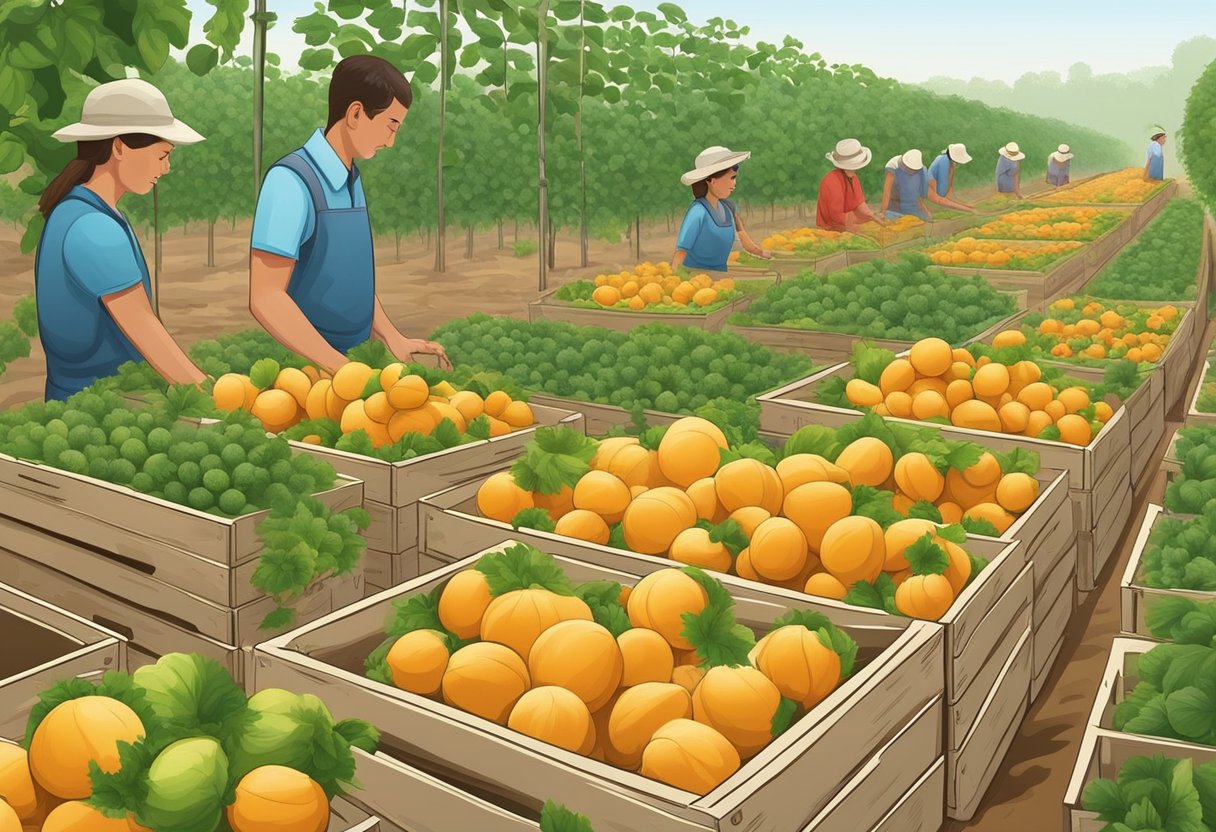
Storage Conditions
After harvesting cantaloupes, it is important to store them properly to maintain their quality and extend their shelf life. Cantaloupes should be stored in a cool, dry place away from direct sunlight. The ideal temperature for storing cantaloupes is between 45 and 50°F (7 and 10°C).
To prevent damage to the fruit, it is important to handle them gently during storage. Cantaloupes should not be stacked on top of each other, as this can cause bruising and damage to the fruit. Instead, they should be placed in a single layer on a shelf or in a container.
Shelf Life Extension
To extend the shelf life of cantaloupes, it is important to keep them dry and cool. Moisture can cause the fruit to spoil more quickly, so it is important to avoid storing them in a humid environment.
One way to extend the shelf life of cantaloupes is to wrap them in plastic wrap or place them in a plastic bag. This can help to prevent moisture loss and keep the fruit fresh for longer.
Another way to extend the shelf life of cantaloupes is to store them with other fruits that produce ethylene gas, such as apples or bananas. Ethylene gas can help to ripen the fruit and extend its shelf life. However, it is important to monitor the fruit closely to ensure that it does not over-ripen and spoil.
Proper storage conditions and shelf life extension techniques can help to maintain the quality and extend the shelf life of cantaloupes after harvesting. By following these guidelines, you can enjoy fresh, delicious cantaloupes for longer.
Pest and Disease Management
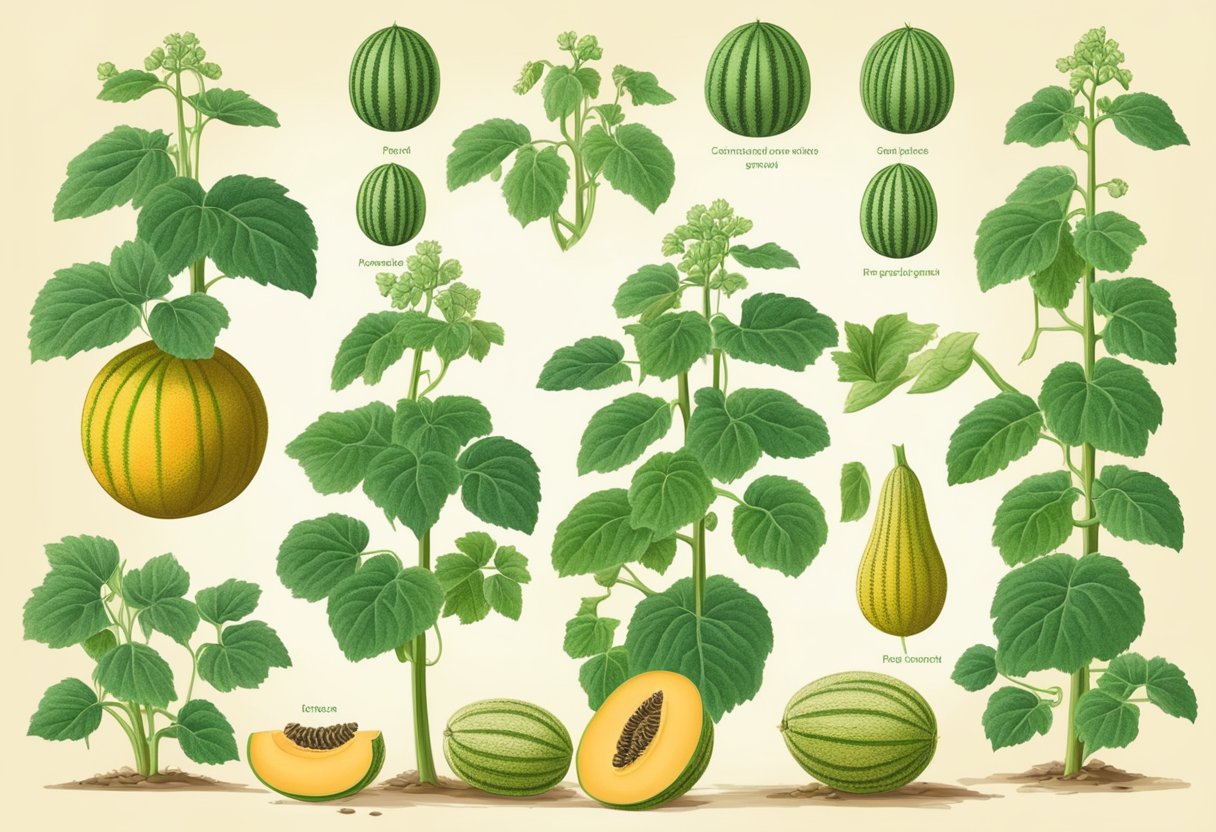
Common Pests
As a cantaloupe plant grows, it is susceptible to various pests that can damage the plant and reduce its yield. Some common pests that can attack cantaloupe plants include aphids, spider mites, and cucumber beetles. Aphids are small, soft-bodied insects that suck the sap from the plant, causing it to wilt and become stunted. Spider mites are tiny arachnids that feed on the underside of the leaves, causing yellow spots on the leaves. Cucumber beetles are small, yellow and black striped beetles that feed on the leaves and stems of the plant, causing extensive damage.
To prevent these pests from attacking your cantaloupe plants, you can use insecticidal soap or neem oil. These organic solutions are effective in controlling pests and are safe for the environment. You can also use physical barriers such as row covers or netting to prevent pests from reaching your plants.
Disease Prevention
Cantaloupe plants are also susceptible to various diseases that can cause serious damage to the plant and reduce its yield. Some common diseases that can affect cantaloupe plants include powdery mildew, downy mildew, and bacterial wilt. Powdery mildew is a fungal disease that causes a white powdery coating on the leaves and stems of the plant. Downy mildew is another fungal disease that causes yellow spots on the leaves and can eventually kill the plant. Bacterial wilt is a bacterial disease that causes the plant to wilt and eventually die.
To prevent these diseases from attacking your cantaloupe plants, you can practice good sanitation by removing any infected plant debris from your garden. You can also use fungicides or bactericides to prevent the spread of diseases. It is important to follow the instructions on the label carefully when using these chemicals to avoid damaging your plants or the environment.
By taking preventive measures and practicing good sanitation, you can ensure that your cantaloupe plants remain healthy and productive throughout their life cycle.
Environmental Factors Affecting Growth
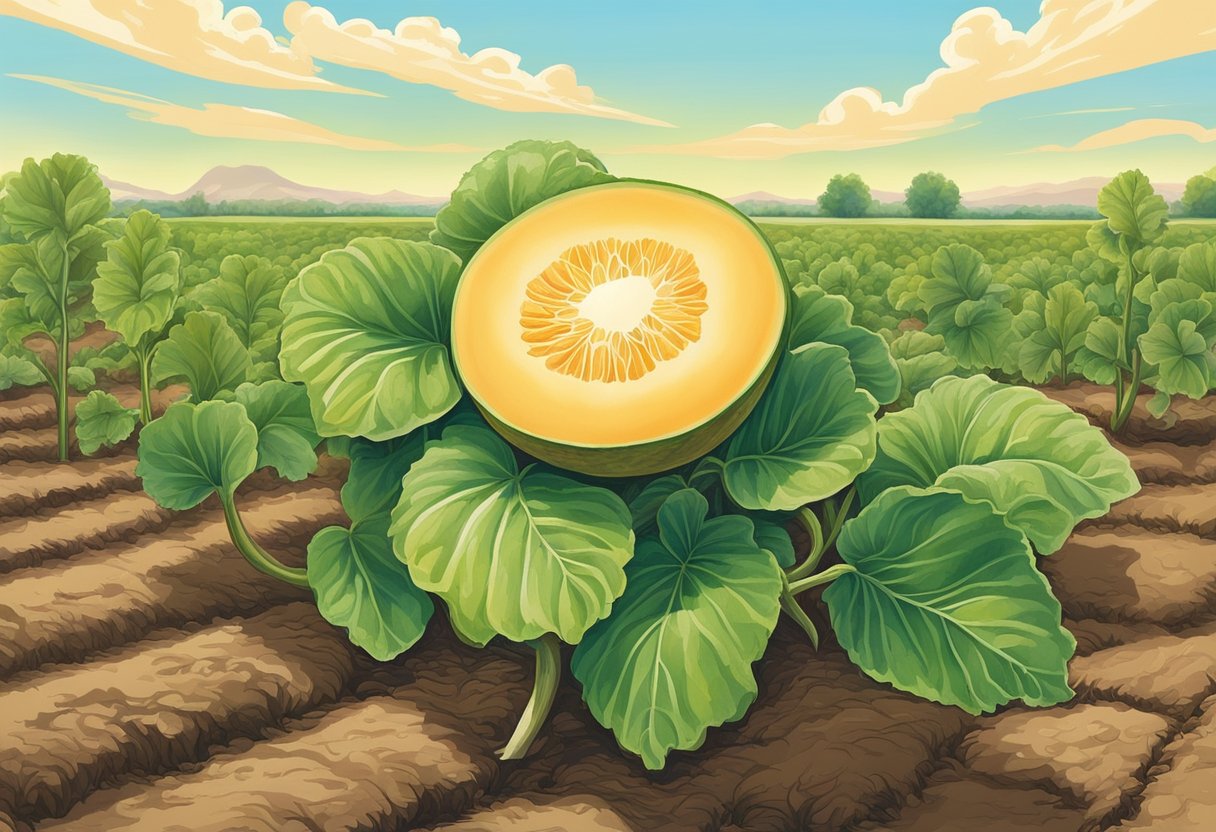
Cantaloupes are sensitive to environmental factors, and their growth can be significantly affected by the conditions they are grown in. In this section, I will discuss the two most important environmental factors that affect the growth of cantaloupes: temperature and climate and soil and water requirements.
Temperature and Climate
Cantaloupes grow best in warm, sunny climates with temperatures between 70°F and 85°F. They require a lot of sunlight to grow and produce fruit, so it is important to plant them in an area with full sun exposure. If the temperature is too cold, the plant growth will be stunted, and the fruit will not develop properly.
On the other hand, if the temperature is too hot, the fruit may ripen too quickly, resulting in poor quality fruit. In hot climates, it is important to provide shade for the plant during the hottest part of the day to prevent sunburn.
Soil and Water Requirements
Cantaloupes require well-drained soil that is rich in organic matter. Before planting, it is important to prepare the soil by adding compost or aged manure to improve soil fertility. The ideal pH range for cantaloupes is between 6.0 and 6.5.
Cantaloupes also require consistent moisture throughout the growing season. Watering should be done deeply and regularly to keep the soil moist. However, overwatering should be avoided as this can lead to root rot and other problems.
Cantaloupes are sensitive to environmental factors, and their growth can be significantly affected by the conditions they are grown in. To ensure healthy growth and high-quality fruit, it is important to provide the right temperature and climate and soil and water requirements.
Also Read | Hydrangea Leaves Turning Yellow: Causes and Solutions
FAQs – Cantaloupe Plant Growth Stages
What are the different stages of growth for a cantaloupe plant?
A cantaloupe plant goes through several stages of growth during its life cycle. These stages include the seed stage, the seedling stage, the vegetative stage, the flowering stage, and the fruiting stage. Understanding these stages is crucial for successfully cultivating cantaloupes.
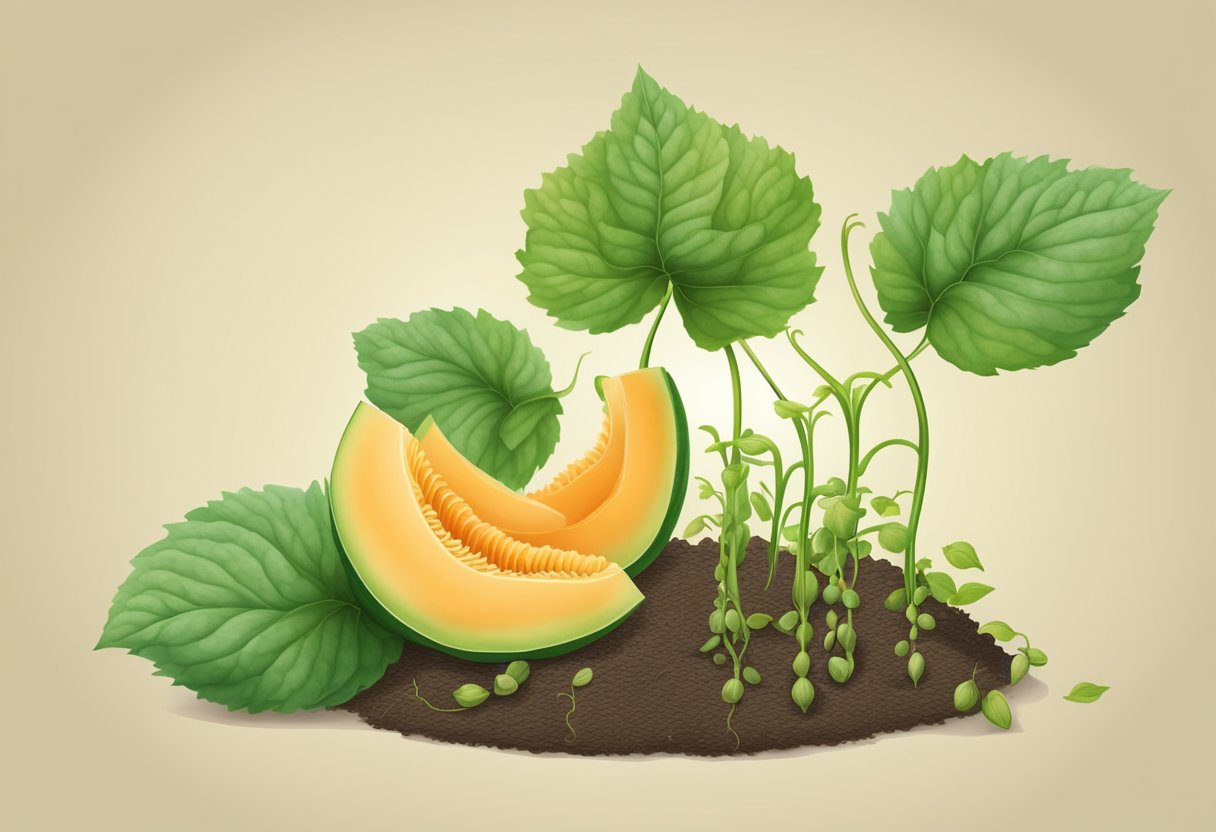
How long does it typically take for a cantaloupe to mature from planting?
The time it takes for a cantaloupe to mature from planting depends on several factors, such as the variety of cantaloupe, the growing conditions, and the climate. On average, it takes about 80 to 100 days for a cantaloupe to mature from planting.
What are the ideal conditions for growing cantaloupe vertically?
Growing cantaloupe vertically is a great way to save space and increase yields. The ideal conditions for growing cantaloupe vertically include providing the plant with a sturdy trellis or support structure, ensuring that the soil is well-draining and rich in nutrients, and providing the plant with plenty of sunlight and water.
How many fruits can one expect from a single cantaloupe plant?
The number of fruits that one can expect from a single cantaloupe plant depends on several factors, such as the variety of cantaloupe, the growing conditions, and the care given to the plant. On average, a single cantaloupe plant can produce anywhere from 2 to 6 fruits.
What are the signs of a cantaloupe plant transitioning from flowering to fruiting?
The transition from the flowering stage to the fruiting stage is an important milestone in the life cycle of a cantaloupe plant. Signs of this transition include the appearance of small fruit on the plant, the development of a thicker stem, and the slowing down of new growth.
Can cantaloupe be effectively grown in containers, and if so, how?
Yes, cantaloupe can be effectively grown in containers, as long as the container is large enough and the plant is given the proper care and attention. To grow cantaloupe in containers, use a pot that is at least 5 gallons in size, fill it with well-draining soil, and provide the plant with plenty of sunlight and water.